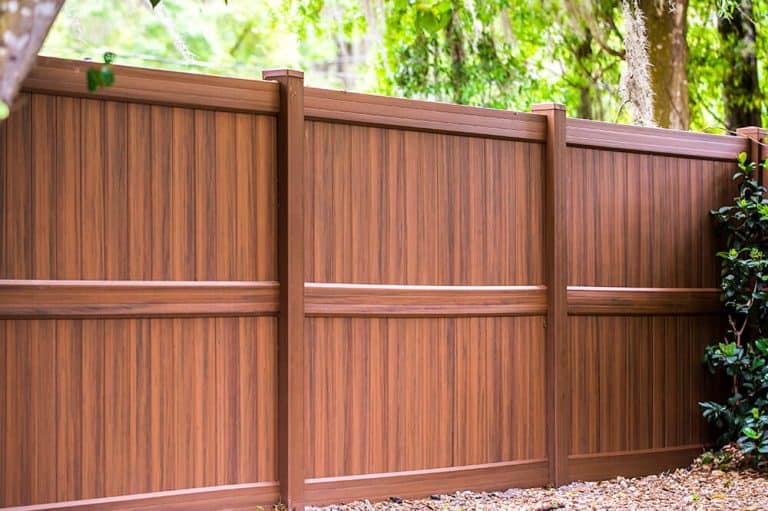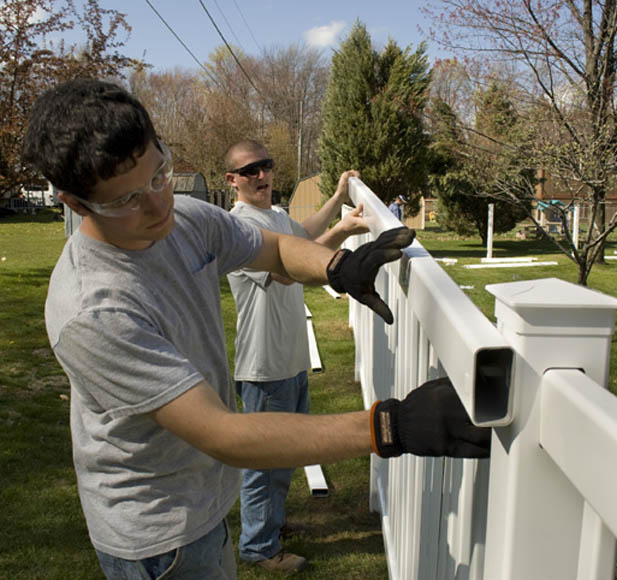How to Identify Typical Issues That Need Immediate Fencing Fixing
It is crucial to find issues before they come to be larger troubles when it comes to preserving your fence. Consistently looking for signs of rotting timber, leaning panels, or rust can conserve you money and time in the future. You could not recognize exactly how climate and insects can endanger your fencing's stability. Allow's check out the usual indications that indicate your fencing requires prompt focus, so you can keep your building safe and secure and looking its ideal.
Indicators of Rotting Timber in Wooden Fences
Have you discovered your wooden fence looking a bit worse for wear? If so, it could be time to check for indications of deteriorating wood. Analyze the base of the messages and panels for soft places. If you press on the wood and it really feels mushy or falls apart, that's a clear indicator of rot. Next off, look for discoloration or dark places on the wood-- these usually signal moisture damage. Focus on any type of peeling off paint or surface, as this can subject the timber to more decay. Furthermore, a poignant, stuffy smell can suggest fungal growth. Don't forget to evaluate joints and links; if they hang or crumbling, the timber beneath is likely jeopardized. By capturing these indicators early, you can stop much more substantial damage and maintain your fence standing strong. Routine maintenance is essential to extending the life of your wooden fencing.
Leaning or Tilting Fencing Panels
If you have actually noticed your fencing panels leaning or tilting, it's vital to understand what triggered it. This concern could suggest underlying structural damage that requires your focus. Let's explore the typical reasons and the repair choices readily available to get your fence back in form.

Root Causes Of Leaning Panels
It's usually a sign of underlying problems that need addressing when you observe your fence panels leaning or tilting. One common reason is inadequate drain; excessive water can erode the dirt around the fencing posts, deteriorating their assistance. One more offender can be solid winds or storms that press versus the panels, particularly if they're not effectively secured. Furthermore, the all-natural settling of soil gradually can trigger articles to move, resulting in a tilt. Insects, like termites, can endanger the integrity of wooden panels, creating them to lean also. Lastly, poor setup techniques might lead to panels not being firmly established, leaving them vulnerable to leaning under pressure. Address these problems promptly to maintain your fence's honesty.
Indications of Structural Damages
Observing turning or leaning fencing panels can be startling, as these concerns commonly suggest structural damages that requires instant focus. When your fence begins to lean, it might signify that the posts are moving or that the soil around them has worn down. Pay very close attention to spaces in between panels or articles, as these can likewise recommend instability. deck builder. Additionally, check for splits or splintering in the wood, which can weaken the general structure. If you notice rust or deterioration on metal elements, it could jeopardize the stability of the fence. Remember, neglecting these signs can result in much more serious damage down the line, so it's vital to assess the circumstance immediately and do something about it before it aggravates
Repair Service Options Available

Rust and Rust in Metal Fences
If you have a steel fencing, you may observe corrosion and rust slipping in over time, particularly if it's subjected to dampness. These concerns not just influence the appearance of your fence yet can also endanger its architectural integrity. To recognize rust, try to find reddish-brown areas or spots, which indicate the metal is oxidizing. Corrosion can spread rapidly if left neglected, compromising the fence and leading to expensive repairs.To deal with rust and rust, you should clean up the impacted areas with a wire brush and apply a rust-inhibiting primer. Once the guide dries, take into consideration repainting the fence with a weather-resistant paint to shield it even more. Normal maintenance, such as evaluating for indications of rust and retouching paint as needed, will certainly assist expand your fence's lifespan. Resolving these concerns quickly assures your steel fencing stays strong and aesthetically appealing for several years ahead.
Cracks and Splits in Vinyl Fence

Root Causes Of Vinyl Damage
Vinyl fence is popular for its durability, yet it can still struggle with splits and divides as a result of various aspects. One significant cause is extreme temperature variations. When vinyl broadens in the warmth and agreements in the chilly, it can deteriorate the product with time. Additionally, exposure to severe sunlight can cause UV degradation, making the plastic weak. Physical effects, like unexpected collisions or hefty branches, can additionally develop splits. Poor setup or utilizing low-grade materials can worsen these concerns. In addition, age contributes; older vinyl secure fencing is extra susceptible to damages. Routine assessments can assist you identify these elements before they lead to considerable troubles. Take proactive measures to assure your fencing continues to be undamaged and strong.
Fixing Cracks Successfully
Although fractures and divides in your vinyl fence can be concerning, addressing them without delay can protect against additional damage and maintain the fence's look. Examine the dimension of the split. For little fractures, a plastic repair service kit often includes adhesive that can bond the edges, supplying a seamless fix. Clean the location extensively before using the adhesive, guaranteeing it sticks properly. For bigger splits, you may require to make use of a plastic spot. Cut the spot to dimension, apply glue around the edges, and press it securely onto the split. Enable it to treat according to the producer's guidelines. Normal upkeep and fast fixings can prolong your fencing's life-span, original site maintaining it looking excellent for years ahead.
Loose or Missing Out On Fence Articles
Absent or loosened fencing blog posts can undermine the stability of your entire fencing framework. It's crucial to deal with the concern immediately if you see any type of blog posts leaning or tottering. Examine for any type of indicators of movement, as this can result in further damages with time. You can conveniently examine the issue by providing each post a gentle shake-- if it feels unstable, it's time to take action.For missing out on blog posts, you'll need to change them as quickly as possible to preserve your fencing's stability. Make sure they're securely anchored in the ground with concrete or crushed rock for included stability when you set up new messages. If an article hangs, tighten it by adding additional assistance or driving it deeper right into the ground.Ignoring these problems can lead to bigger problems, like voids in your fence or also complete collapse. So, maintain an eye on your messages and stay proactive regarding repair work!
Damage From Climate and Natural Environment
Weather condition and natural environments can ruin your fence, bring about numerous types of damages that call for punctual interest. Hefty rain can trigger timber to rot, making it unpredictable and weak. Snow build-up may flex or break panels, while solid winds can root out fence blog posts or trigger areas to lean.If you discover fractures or splintering in wood fencings, it's an indication of drying as a result of extreme sun direct exposure. Metal fencings can corrosion if safety layers put on off, specifically in seaside or humid areas.Inspect your fence routinely after tornados or extreme weather condition to capture any damage early. Resolving these issues rapidly can conserve you from costly fixings down the line. Do not wait until a small issue turns right into a significant one; stay proactive and maintain your surround top shape to preserve both capability and visual allure.
Bug Infestation and Termite Damage
It's necessary to act quickly to prevent further damage when you observe indications of bug problem or termite damages. Search for mud tubes along your fence or hollow-sounding wood, as these indicate termites are at job. You might likewise see small openings or frass, which is termite droppings resembling sawdust. If you spot any one of these signs, it's time to analyze the damage.Don' t wait till it's far too late; pests can compromise your fence's stability. Inspect the surrounding area for ants or beetles, as they might be contributing to the trouble. If you suspect an infestation, consider speaking to a pest control expert to validate and deal with the issue.Repairing or replacing afflicted sections of your fence without delay not just recovers its toughness but also stops pests from spreading better. Remain attentive to maintain your home protected and pest-free.
Frequently Asked Inquiries
Just how Frequently Should I Inspect My Fence for Damages?
You must check your fencing at least twice a year, preferably during spring and loss. Regular checks assist you spot damages early, conserving you time and cash on repair services while preserving your building's look and security.
Can I Repair a Fence Myself or Employ a Professional?
You can definitely fix a fencing on your own if you have the right tools and abilities. Working with an expert guarantees quality job and saves you time, particularly for complex repairs or extensive damages.
What Equipment Are Required for Fundamental Fence Repair Services?
For basic fencing fixings, you'll need devices like a hammer, screwdriver, pliers, a saw, a degree, and measuring tape. deck builder. Relying on the repair service, you might additionally require nails, screws, or substitute boards
Just How Much Does Fence Fixing Generally Cost?
Fence fixing costs differ commonly, but you can expect to pay in between $200 and $1,500 relying on products, labor, and extent of damage. It's clever to get several quotes for the ideal offer.
When Is the very best Time of Year for Fence Repairs?
The ideal time click to investigate for fencing fixings is throughout light weather condition, generally in spring or early fall. You'll prevent severe temperatures, making it easier to work and ensuring the materials set effectively for lasting resilience (deck builder). Discovering leaning or turning fence panels can be startling, as these problems frequently show structural damage that requires prompt attention. Loosened or absent fencing messages can undermine the stability of your whole fence framework. Snow accumulation might bend or break panels, while solid winds can root out fence blog posts or cause sections to lean.If you notice splits or splintering in wooden fencings, it's a sign of drying out due to extreme sun direct exposure. official website Steel fences can corrosion if protective finishes use off, particularly in humid or coastal areas.Inspect your fence routinely after tornados or severe climate to catch any type of damages early. Fence repair work costs differ extensively, yet you can expect to pay in between $200 and $1,500 depending on products, labor, and extent of damages